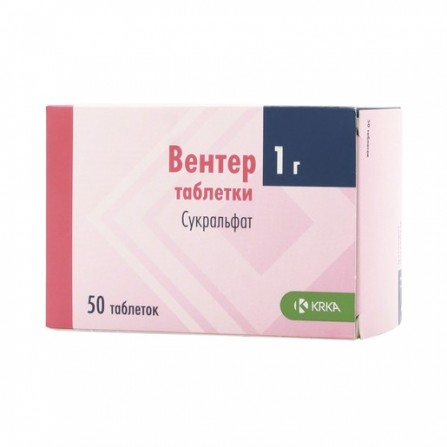More info
Active ingredients
Sucralfat
Release form
Pills
Composition
1 tablet contains: Active substance: sucralfate 1 g.
Pharmacological effect
Gastroprotective agent. Interacting with the proteins of the necrotic tissue of the ulcer, it forms a protective layer that prevents the further destructive action of pepsin, hydrochloric acid and bile salts. Increases prostaglandin synthesis, reduces the activity of pepsin and binds bile salts. Inhibits pepsin activity by 30%. It has a weak antacid effect. Being in the stomach and duodenum, it is transformed into a polyanion with many free negative charges that form strong bonds with the positive radicals of the protein-like exudate (albumin, fibrinogen) of the mucous membrane. Interaction with unchanged mucous membrane is negligible.
Pharmacokinetics
Low absorption - 3-5% of the administered dose (up to 5% of the disaccharide component and less than 0.02% of aluminum). Excreted through the intestines - 90% unchanged; a small amount of sulfate disaccharide that has entered the bloodstream is excreted by the kidneys.
Indications
Peptic ulcer and duodenal ulcer in the acute phase; Prevention of exacerbation of duodenal ulcer; Hyperphosphatemia in uremia patients on hemodialysis; Reflux esophagitis; Prevention of stress ulcers.
Contraindications
Severe renal dysfunction, children under 4 years of age, hypersensitivity to sucralfate and other components of the drug. With care: chronic renal failure (CRF) (the risk of aluminum intoxication), pregnancy, lactation.
Precautionary measures
Do not exceed recommended doses.
Use during pregnancy and lactation
Use caution during pregnancy and lactation.
Dosage and administration
Inside, without chewing, washing down with a small amount of water, 1 hour before meals and before bedtime. Peptic ulcer of the stomach and duodenum in the acute phase: inside 1 tablet (1 g) four times a day or 2 pills (2 g) twice a day. The maximum daily dose is 8 g. The average duration of the course of treatment is 4-6 weeks, if necessary up to 12 weeks.Prevention of acute exacerbations of duodenal ulcer: 1 tablet twice a day. Reflux esophagitis: 1 tablet three times a day before each meal and 1 tablet at bedtime. Hyperphosphatemia: 1 tablet four times a day before meals and before bedtime. In patients with hyperphosphatemia, with a decrease in plasma phosphate concentration, the dose of sucralfate may be reduced. The duration of therapy for reflux of esophagitis, hyperphosphatemia, as well as for the prevention of exacerbations of gastric ulcer and duodenal ulcer is determined by the patient's clinical condition and the results of the examination in the dynamics, individually by the attending physician. Children over 4 years old: 1/2 to 1 tablet (0.5-1.0 g) four times a day one hour before meals and at night, i.e. at a dose of 40-80 mg per kg of body weight per day, divided into 4 doses.
Side effects
Constipation, rarely - nausea, vomiting, diarrhea, flatulence, dry mouth, headache, insomnia, drowsiness, dizziness, gastralgia, pain in the lumbar region, allergic reactions (pruritus, rash, rash).
Overdose
Information about cases of overdose are absent.
Interaction with other drugs
With simultaneous use with indirect anticoagulants, it is possible to reduce their anticoagulant activity (including warfarin). With simultaneous use, the absorption of antimicrobial agents for fluoroquinolone derivatives decreases. simultaneous use may form chelate complexes with amphotericin B sucralfate, colistin sulfate, tobramycin, which may lead to a decrease in their antimicrobial activity. With simultaneous use with digoxin, digoxin absorption may be reduced. It is possible that with simultaneous use, a slight decrease in ketoconazole and fluconazole absorption is observed. When used simultaneously with levothyroxine, the effectiveness of levothyroxine is noticeably reduced. It is also believed that a significant decrease in theophylline absorption from sustained release dosage forms is possible.that with simultaneous use, it is possible to reduce the absorption of tetracycline. With simultaneous use, the absorption of phenytoin and sulpiride is reduced. A case of decreasing the concentration of quinidine in the blood plasma while using with sucralfate is described.
special instructions
If necessary, the simultaneous use of antacids should be taken 30 minutes before or 30 minutes after taking sucralfate. In case of renal insufficiency, it is necessary to control the concentrations of aluminum and phosphate in the serum. The appearance of drowsiness and cramps may indicate manifestations of the toxic effect of aluminum. Short treatment can lead to complete scarring of the ulcer, but does not change the frequency and severity of the recurrence of peptic ulcer after scarring. The introduction of sucralfate through a nasogastric tube can lead to bezoara (calculus formed in the digestive tract and having the form of a ball) with other drugs or solutions for enteral nutrition, because sucralfate can bind protein.





